


Inner Barcelona - south of Placa de Catalunya - includes the historical quarters and the waterfront, the vibrant areas of Barcelona, plus one or two of Gaudi's works.
See also Outer Barcelona & La Sagrada Familia


April 23rd is a particularly busy time in Barcelona as it is the feast of St George - the patron saint of the city. As a consequence, hotel rooms in the city are at a premium. In 1999 we had to move half way through our stay as we'd left it quite late to reserve! In 2014, in June, we had no such problems, and stayed a block off la Rambla.

La Rambla is the focus of festival activities but at any time of year everyone comes to the long main street of Barcelona to browse the stalls, sit at a pavement café, watch the street entertainment, or just stroll. It is the main thoroughfare and stretches from busy Placa de Catalunya to the sea, lined with hotels, shops and places to eat.



At the time of the St George festival the stalls along the Rambla are devoted to books and red roses as the tradition is for men to give a red rose and women to give a book. One of our hotels gave us both which was nice.
With over a kilometer of stalls, cafés and street entertainers it is very popular with tourists and locals alike, though it is wise to be vigilant, especially in the more popular tourist areas in Barcelona, due to the prevalence of pickpockets.







This colourful market - Mercat St. Josep, La Boqueria - fills the impressively columned Placa del Treballon on the west side of la Ramblas.
In 1999 there were no tourists inside when we wandered around. In 2014 it was heaving with them!




Very lively and with all of the fresh fruit vegetables, meats and cheeses beautifully presented, though in 2014 we noticed several vendors with "no photos" signs.


For me the most interesting section is the seafood, grouped around a central station with sinks and a beautiful fountain which has more than an echo of Gaudi design to it!

The origins of the market date back many hundreds of years but in its present situation it developed in stages form the mid nineteenth century.1


Park Guell and the fish market were created at roughly the same time, early in the twentieth century.

 Palau Guell is on a narrow street, Carrer Nou de la Rambla.
Palau Guell is on a narrow street, Carrer Nou de la Rambla.






The industrialist Eusebi Guell commissioned Gaudi to to create this palace in 1888 when Gaudi was 34. Gaudi had worked on Guell's summer residence and had greatlyimpressed him.2
Antoni Gaudi was born on June 25, 1852 in Reus. At school he showed an early interest in architecture and at 17 he went to Barcelona to begin a course of formal study, also working in the offices of local architects to earn some money.3 He exhibited at the Paris World fair in 1878 which led to Gaudi's friendship with Güell, a wealthy brick manufacturer, who shared Gaudi's social ideals. Gaudi became his favourite architect and completed several projects for him.
We stopped by the palace on our first day and overheard a guide saying that it was free entry late on Sundays, so we returned on Sunday!
The entrance is somewhat severe, but with beautiful parabolic arches and some very impressive wrought ironwork, including fearsome snakes!
The huge gates were designed by Gaudi for a purpose: to allow guests to ride directly into the palace in their carriages.3 Inside, at the rear, is the coach house where the horses would be unhitched from the carriages.



A gently sloping ramp leads down to the underground stables, which could also be reached by a spiral ramp.
The stables are a lovely space, very simply designed in brickwork with huge pillars.
Inside the vestibule the grey pillars are made from snake eye stone, an expensive material brought all the way from the Pyaranees and used throughout the palace. I wouldn't say it's the most attractive coloured stone.



There are mounting blocks either side of a grand staircase which leads to a mezzanine level and another staircase to the main floors.
On this floor are some beautiful parabolic arches set in front of windows - rather difficult to photograph on such a bright day.
The family rooms are here, including three interconnecting spaces of a music room, smoking room with a beautiful bay window, and a dining room.
Here also is the connecting corridor to the Guell residence on la Rambla.

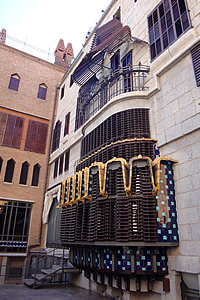


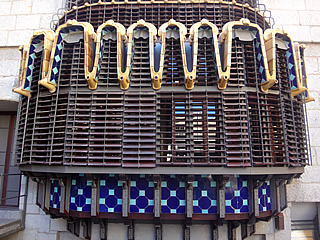



On the south terrace at this level the smoing room bay window can be seen in all its glory.
On this same level is the entrance to the Hall of Lost Steps with a magnificent coffered ceiling and parabolic arches fronting windows which look out onto the street.
Nearby is a small visitors hall and dressing room for guests who would then retrun through the Hall of Lost Steps and enter the Central Hall. This is an immensely impressive space, rising three floors to a parabolic domed ceiling.


The dome is covered with hexagonal tiles with regularly spaced circular glass insets to allow light in and to give the appearance of starlight at night.3
This room was used for entertainments such as music recitals.
At one side of a large set of double doors - which when opened reveal a chapel - there is an organ console.
Up the stairs and through the musicians' area, where they set up ready for a concert, and another flight leads to the Hall of Intimates.




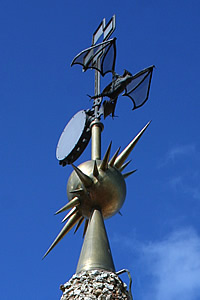
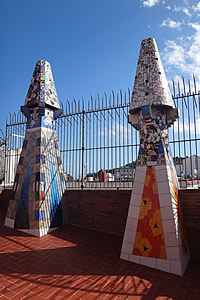


The Hall of Intimates was the family sitting room off which were the family bedrooms.
These rooms are grouped around a gallery which encircles the upper level of the Central Hall. Choirs would sing on the gallery here during concerts.4
Gaudi also designed some of the fireplaces in the house, all of those with a parabolic opening, though those squeezed into arches look like an afterthought.





This is not one of my favourite Gaudi buildings. It is too dark, verging on the gothic in places, but I do like the underground stables and the roof with its many multi-coloured chimneys.



The chimneys were restored in 1992, those with the majority of their tiles still in place as faithfully as possible. Those tiled chimneys which had lost most of their tiles were restored in sympathetic designs. In the case of the brick chimneys the original models were followed.

At the bottom of the servants' staircase is one final surprise: a beautifully cast shadow from the iron railing.

The fourth century Roman wall once extended 1270m around the Roman settlement of Barcina and had four gates.5 There is a good section of wall at Placa Ramon Berenguer, the gate towers of Port Praetoria and wall towers in Placa Nova and excavations in the Historical Museum on Placa del Rei.





The wall on Placa Ramon Berenguer has been incorporated into the fourteenth century Royal Chapel of Santa Agata and the Royal Palace.




The historical museum is entered through a courtyard on the opposite side of the Royal Chapel and leads to Roman excavations beneath Placa del Rei.
The Roman remains date from between the first and sixth centuries A.D. and include work places such as a laundry and dye shops as well as thermal baths and epsicopal buildings.

One area is devoted to salted fish and the preparation of garum, a popular fish sauce. Large ceramic vessels called dolia were used to prepare and store garum.
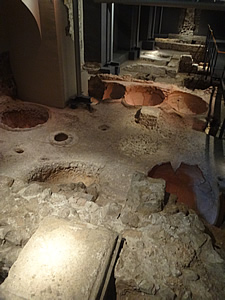
Another houses a wine-making facility complete with dolia, in which the wine was processed and aged, and vessels to hold honey and sea salt which were added to the wine.

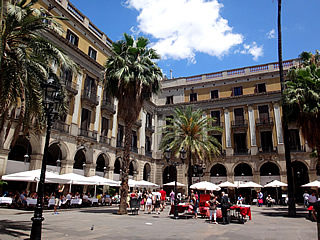
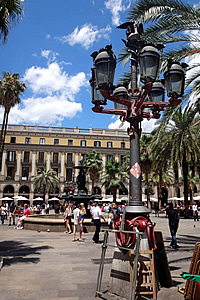
Placa Reial, just off the east side of la Ramblas, is a nice place to have drinks or lunch. It also has one of Gaudi's first commissions: in 1878 he designed a pair of lamp posts!
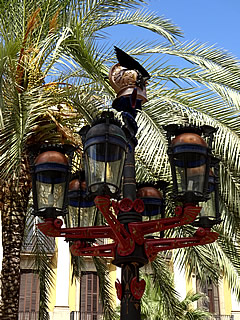
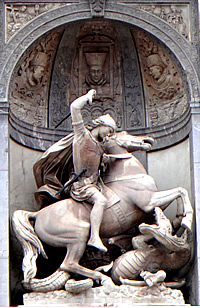





The gothic quarter stretches north east from the Placa Reial. This is the oldest area of the city going back to Roman times. At its centre is the Placa Sant Jaume, the old Roman forum, a large square now lined with civic buildings and the church which gives it its name. We had a great meal at Bodega Biarritz on Carrer Nou de Sant Francesc - an excellent selection of tapas in a cosy setting.

Off the north side of the square is the Carrer del Bisbe running along the east side of the Palau de la Generalitat with its gargoyles - the building dates from medieval times and has undergone several renovations and additions. Crossing the passage is the famous neogothic bridge.


The gohic cathedral lies on the east side of carrer de la Bisbe with an entrance to the cloisters. Catedral de la Santa Creu i Santa Eulalia - Cathedral of the Holy Cross and Saint Eulalia - is also known as La Seu.



The fourteenth century cloisters are peaceful with fountains and thirteen geese wandering about in the central enclosure - one for each year in the life of Santa Eulalia.4The main entrance of the cathedral faces north west onto Placa Nova and just north east of here is one of the city's famous markets, Santa Caterina, with a colourful roof and fresh produce inside. It was just closing when we passed by but looks less touristy than la Boqueria has become.

We had a really great meal at the Pla restaurant in the gothic quarter. The people there were so friendly and helpful and the food fantastic.

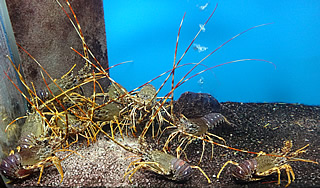

We haven't spent much time at the Barcelona shore, in fact only to eat one evening and to walk along the front to see the Frank Gehry fish!

